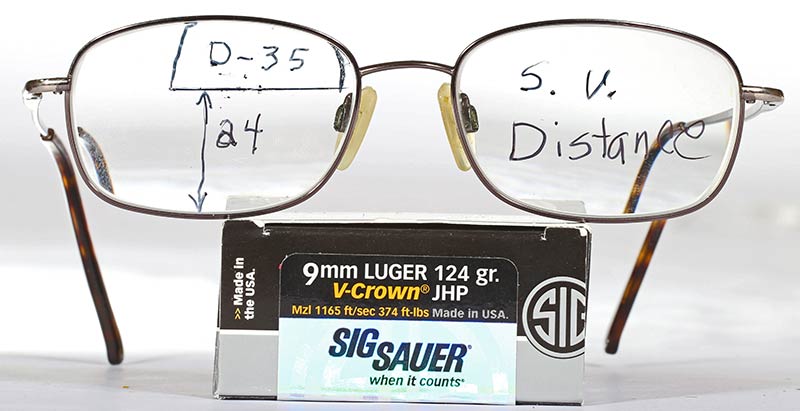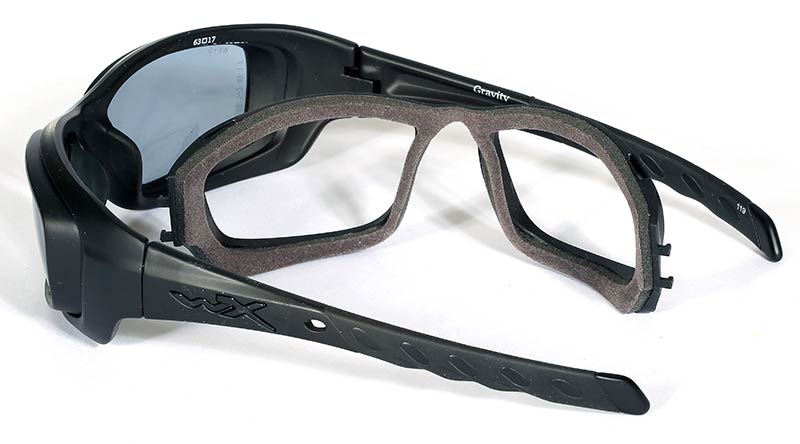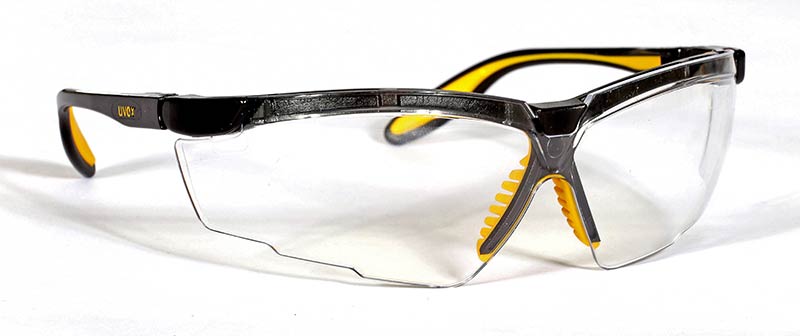I can see clearly now!
Shooting Glasses Demystified
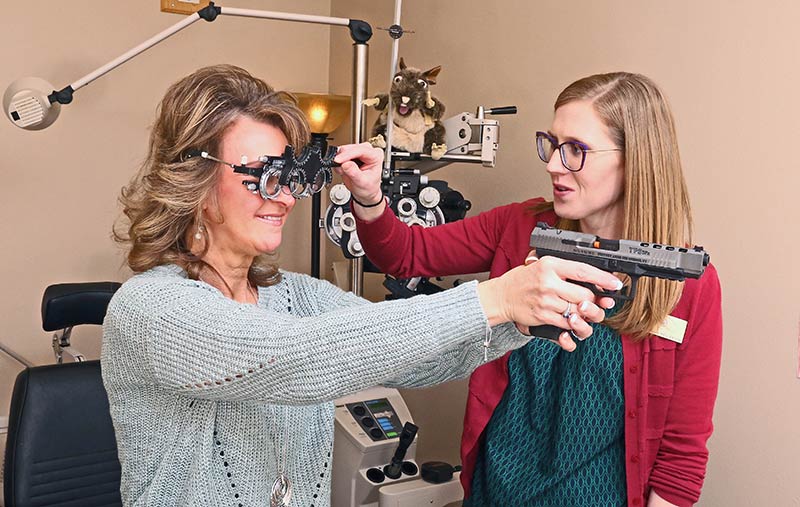
Leslie Hellebush, OD is “trial framing” a proposed RX so Gail can see if the front sight is in focus.
She can fine tune the RX by adding and subtracting lenses to get the focal point where Gail wants it. Dr. Hellebush practices at Schindler and
Deis Optometry in Bismarck, ND. (Note: Slide is open, the orange chamber indicator is inserted and Gail’s finger is outside of the trigger guard.)
Missed the target — again! It might be time to have an eye exam. I know you’re really enthused, but knowing a little about optometry and eyewear can make that process less painful — and more successful.
Not all eye exams are equal. An optometrist in a small private practice is more likely to spend time with you and thoroughly assess your needs. An OD who is a hunter or shooter would be preferred, but not necessary. If you’re “mature” and need a multifocal option, call ahead and ask if you can bring your firearm to the office. Have the firearm discretely cased, unloaded (no ammo on you) so you don’t startle patients or staff members. Lock the slide open on autos. Or you can use a “safe” gun like a “Blue Gun” or “Rings” training gun.
During the exam, demonstrate your stance for the doctor (“aiming” at a safe spot) and have Doc measure from the back of the front sight to your eye. Let the Doc know what type of shooting you’re doing, whether you’re right or left handed and if you shoot with one or both eyes open.
Your Doc should “trial frame” the proposed prescription (RX) for you to try. This step is very critical to making sure the focus point is where “you” want it. Hopefully, your Doc has a space where you can try this out. Finally, mentally and financially prepare for more than one pair of eyewear. Ideally, buy your eyewear where you have your exam. This enables the optometrist and the optician to work together as a team to solve your eyewear needs. Ask about multiple pair discounts and warranties.
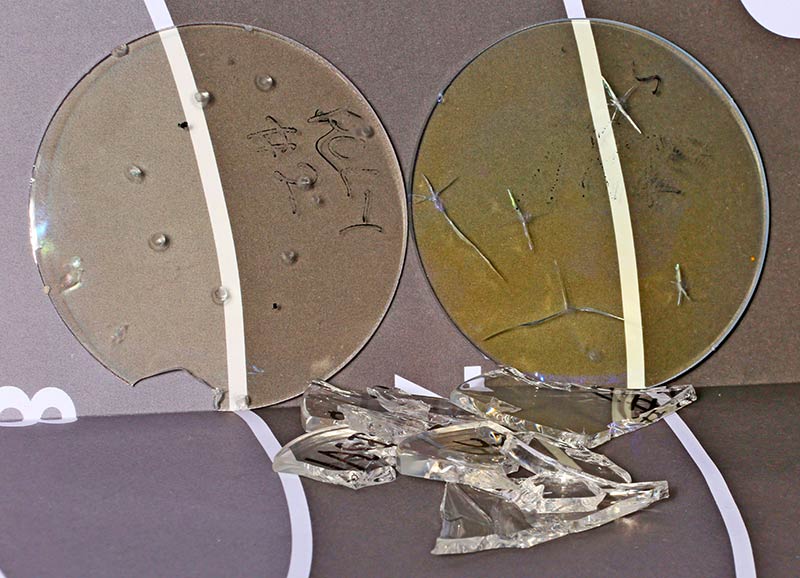
These lenses were tested using .38 Special bird shot and demonstrate clearly why safety lens material is important.
Polycarbonate on the top left held up well other than one small chip. The Trivex on the upper right was the clear winner — it held together.
The standard plastic (CR39) lens (in pieces) shattered on the first round. Yikes!
Lenses
You get what you pay for when it comes to clarity and durability. After all, would you buy a scope with crappy optics? I’ll wager, not knowingly. Understanding the lens materials available is important for making your buying decision.
Polycarbonate: An impact-resistant, lightweight, thin lens material great for safety eyewear. It inherently blocks UV and is inexpensive. The downside is slightly inferior optical clarity.
Trivex: My first pick for safety eyewear if weight, cost and lens thickness are not concerns. It’s a very tough lens material with optical clarity very close to glass.
CR39: The least expensive plastic lens material and should not be used for safety eyewear.
1.67 High Index plastic lenses: This thin lens material is for high RXs. Make sure it is safety rated.
Glass: If you value your eyes, you will never put glass in your shooting glasses because it can shatter on impact. Be aware some non-prescription sunglasses use glass lenses.

Dodger is looking cool in his Wiley X shades, which are safety rated, and is hoarding an assortment of safety frames by Uvex,
3M and Armour Rx. Safety frames come in many sizes, shapes and colors. Most safety frames come with side shields which can either >br>be detachable or permanent. There are some companies, such as Decot Shooters and Target RX, that make frames specifically for shooters
with interchangeable lenses so you can change lenses as your activities and/or light levels change.
Coatings and Tints
Quality anti-glare coatings improve clarity, provide scratch resistance, a UV filter and a two year warranty. If cost is an issue, opt for a scratch coat like TD2 on a poly lens. Cheap anti-glares and scratch coats quickly degrade and you’ll find yourself looking through haze. Tints are sometimes used to increase contrast or reduce glare. Ideally, you’ll have a clear pair and a tinted or polarized pair for specific situations. Ask to see samples of the different tints and try them outside. Be aware your pupils dilate if you have too much tint and that can decrease vision.
Frames
A safety frame is highly recommended. A good optician can point you toward durable frames, fitting and working with your prescription. Price is not always an indication of quality. There are many stylish, modestly priced frames that will do the job. Some companies sell eyewear with interchangeable lenses. That’s a nice feature if you want lenses with different RX’s and/or tints.
Frame Features
Nose pads allow the frame to be fitted to your nose and allow some vertical adjustment for multifocal lenses. They occasionally need to be adjusted or replaced. Spring hinges allow the frame to “spring” back into shape if it gets bonked. This is the frame part most likely to break so make sure the hinges are sturdy. Titanium frames are very lightweight and have fixed hinges because the whole frame is designed to “give.”
Plastic frames have a fixed bridge some people find more comfortable. They work well for people who take glasses on and off frequently or tend to put them on top of their head. The downside is they fit very close to your face — not ideal for people with long eyelashes or who might be perspiring a bit too much in during our trending greenhouse effect!
“Wrap” frames provide great coverage and wind protection, working well for people who don’t need prescription glasses. Find out what the lens material is and if they have any UV blocking. They typically have a steep base curve on the front of the lens some people cannot tolerate in a prescription lens. Some prescriptions will not work with this type of frame and multifocal lens options are very limited.
The Presbyopia Dilemma
Aging eyes lose their ability to refocus from far to near, and getting eyewear to work becomes complex. There’s no one perfect solution for everyone and it might take a few experiments to find your solution. Work with your optometrist and optician to get a good product.
Don’t be cheap and buy your lenses at one of the low-budget on-line or retail outlets. You will just end up spending more money later to buy a better pair. Trust me — I have seen it often! Most reputable ODs will redo lenses within a certain time frame if a particular product does not work for you.
Following are some of the options for the “young at heart” types who want to continue shooting handguns. The trick with any of these is to find the right balance between near and far vision. The intermediate distance might be anywhere from 24″ to 40″ depending on the shooter’s preference and how much blur they can tolerate.

The optician (author Cynthia) is measuring Gail for an inverted bifocal lens which is used by the dominant eye.
The bottom of the bifocal segment needs to be set just above the pupil so the shooter can see distance looking
straight ahead and tilt head slightly down to get front sight in focus. The optician can then draw the segment on the lens so the patient can see what it will look like.
Lined Bifocals
Have the inset portion (bifocal) set for your front sight distance rather than the normal reading RX. The “line” should be set just above your pupil with an upside down bifocal in the lens for the dominant eye. To use, line up on target, then look slightly down to get the sights in focus. The non-dominant eye should have a single vision distance correction. Personally, I have not seen this work for my patients but it is an option some people might like.
Single Vision Intermediate Lenses
These will enable you to have a good sight picture but the distance (target) will be slightly fuzzy. This can often work for action shooters as they do not have their peripheral vision hampered by different lens segments and they are still able to see targets well enough to make good hits. Another plus of this type of lens configuration is it can also be used for the computer or for other activities at that distance. This lens can be set up to have both the front sight and the target blurry. Trial-framing is key to letting you see the blurry balance you want. Both lenses are the same focus distance.
A while ago “His Editorship” Roy Huntington began using what he calls his “computer” glasses (essentially what we’re talking about here) for handgun shooting and he told me he’s had great good luck with that. According to Roy, “Both sights are in reasonable focus, and the target — while out of focus — isn’t bad enough to really cause any issues. It’s made handgun shooting much more fun again!”
No-Line Progressive Lenses
These lenses are many people’s first choice for daily wear and they may work well for handgun also — especially if you have a short sight radius. All of the focal distances are in one lens. Action shooters might find the lack of peripheral vision problematic but the new lens designs keep getting better and better. If you gave up on progressive lenses 10 years ago, I would suggest you give them another try. I recently fitted a gentleman — who competes in multiple shooting sports — with the latest generation of progressives and he’s finding those to work well overall for him.
Monovision
This involves using a single vision intermediate lens for the shooting eye and a single vision distance lens for the other eye. Out of curiosity, we used my hubby, Ray, for a guinea pig to try out the various lens options. He found this option to work best for him for target shooting. The shooting distance was 24 yards and his intermediate (shooting) lens was set for approximately 40”. For everyday shooting, hunting, etc. he prefers his new progressive lenses set in a good-sized frame. His progressive lenses are a Varilux X design made by Twin City Optical in Bismarck, an Essilor lab.
Contact lenses
Your optometrist can help you determine the best option here. Be sure to wear safety glasses with your contacts
If All Else Fails?
Indulge in a good red dot site to work with your normal multifocal option. I tried a Leopold reflex red dot site this past weekend and it totally rocked!
Maintenance
Don’t be a glasses slob! A few minutes of careless behavior can destroy hundreds of dollars of lenses. Don’t leave glasses sitting on chair cushions, etc.! A lens warranty won’t do you any good if you can’t see through your lenses in the middle of a competition or hunting adventure.
Lens Care
Keep a jug of water, lens cleaner and a clean cleaning cloth on hand. Rinse off dirt/grit and then clean. If your glasses get really greasy, use a little mild dish soap. And pleeeaase … don’t use your dirty shirt, Kleenexes, paper towels or synthetic fabrics to wipe your lenses! Use cotton, linen or a cleaning cloth provided by your eye Doc. Kim wipes (disposable lens cleaning tissues) also work well. Don’t use solvents on your lenses. They will eventually (or immediately) destroy your lens coatings. This includes vinegar, alcohol, window cleaner and most prepackaged lens wipes even if they claim they’re safe for eyewear. No Lens Pens or scope cleaning products. The coatings are different.
Do take your glasses off with both hands. This helps keep your glasses in adjustment and prevents the inevitable broken hinge that results from one-handed activity.
Don’t leave your glasses on the dash of your vehicle. Excess heat can warp lenses and/or frames. Heat can also delaminate lens coatings.
Don’t use superglue on your broken glasses. Your optician will hate you and you will ruin your lenses! You might also void your frame and/or lens warranty. Electrical tape can work in a pinch. I have seen many creative fixes including band-aids, thread, rubber bands and paper clips.
If you take good care of your glasses, they should last until your next eye exam (or longer). And, if you value your eyesight, do get a regular exam even if you don’t need prescription glasses!
Eye health
Some eye diseases such as glaucoma can be treated if detected early. Once eyesight is lost, it cannot be regained. If you have diabetes, hypertension, an autoimmune disease or any cardiovascular issue, a yearly exam is highly recommended, as any of these conditions can affect your eyes. Patients on certain medications may need to be monitored annually or semi-annually. Dry eyes can interfere with clear vision, so inform your optometrist if you’re struggling with eye discomfort or if your eyes perpetually water, which ironically, is actually a symptom of dry eyes.
Finally
If the eyewear you purchased isn’t doing what you need, go back and calmly and politely explain your problem in detail. I’ve worked with many different optometrists and opticians over the years and most of them genuinely want to help their patients. Don’t suffer in silence and fume about money wasted. They want to help you — really! And, if you’re shooting, wear some kind of protective eyewear, period. Don’t take your eyesight for granted — ever.
Credits: “Twin City Optical of Bismarck, an Essilor of America Lab” provided lenses for testing for this article.

